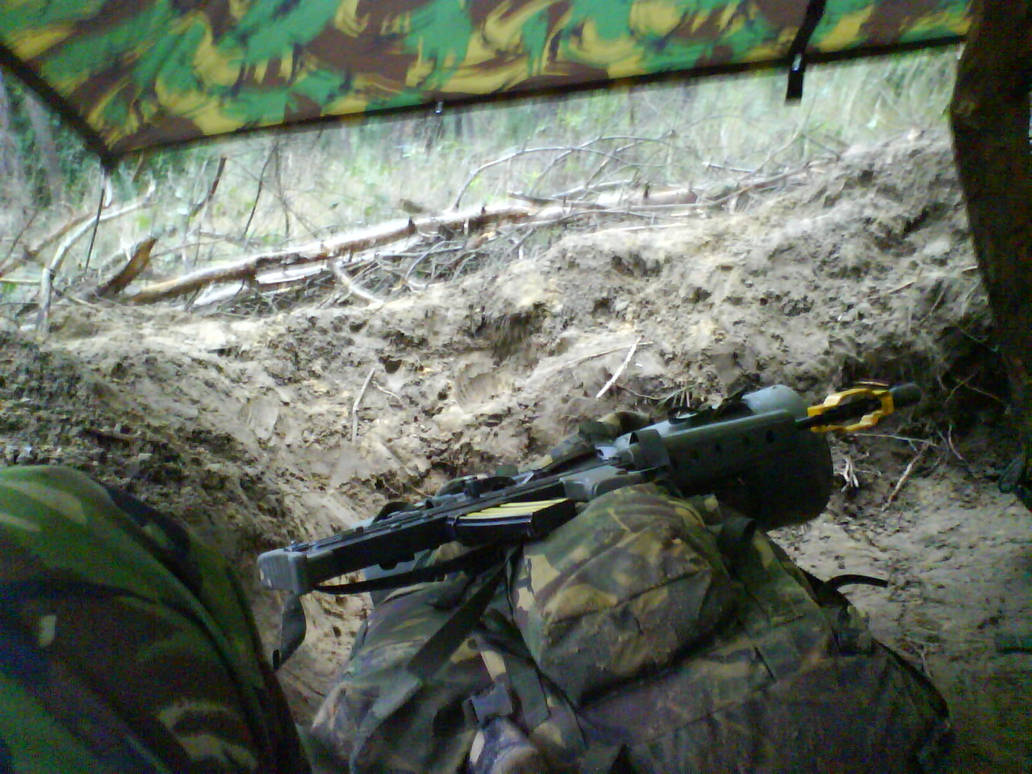Hi all, I'm planning to run a shellscrape activity for some kids, it's to do with a veteran group I'm workingwith.
I was in the Infantry T.A. in the early 90's and the shellscrape was a common overnight shelter for 2 soldiers.
(the kids will be digging it....probably in sand.
If you're an ex infantry soldier you will know what I'm talking about, and you've more than likely dug these and slept in them.
The basic hole dimentions were roughly the same size size of a poncho laid flat on the ground and you dug out a rectangle about the size of a double bed mattress 7ft x 5ft x 2f you'd always add a foot or so gap at the foot end for storage of webbing/bergen.
The removed soil made a rounded wall/mound about a foot wide and high that surrounded the hole on all sizes (apart from a small slope at the rear to crawl in and out) the wall tapered down to groundlevel,
The wall at the front (facing the enemy) was slightly longer perhaps (2ft wide)and had a built in shelf on the inside you could use as an arm rest.
The surrounding mound aprox 1ft tall and wide gave the shelter more internal head height and provided further protection from all directions,
If you got the size right the poncho attatched to nearby branches would sit just above the mound/wall so you could see out and aim your rifle without touching the poncho, and if you got the size just right the poncho would shed rain on the outside of the hole.
I've done a Google search and asked several veterans I know that served in the British Army and RAF regiment from 70's up to the 1st Gulf war, and kosavo, and they all remember making and sleeping in the shellscrape but, were like me, were taught in the field, word-of-mouth. I never saw any training staff use notes or plans so I'm assuming, it was just common knowledge.
My question is this, was there ever an official document or even a line drawing with specific measurements of how the shellscrape should be built?
I'm guessing perhaps if there were a document it would probably date back to post WW2 when "Platoon harbours" type overnight camps became common, perhaps after 2 man tents were a common sight, or perhaps when 58" gear with the poncho and shovel were issued? just a guess.
Apart from 2 leaky shellscrapes I stayed in, I found them really quite comfortable to sleep in, you could adapt them slightly to make more space and because of the surrounding soil they were always quiet and well insulated against wind and cold. once you got a hexy going they were really cosy.
and because they were low to the ground they were very easy to camouflage.
It would be dead easy to just make a shell scrape the way I was taught, but it would be nice to know if there is an official document.
I've looked in British Army issued MoD Aide Memouires, field guides and MoD training pamphlets, "Survive to fight", "Combat and survival" books and magazines but the only thing they ever show is a few "trench designs", never the the humble shellscrape.
This video again shows roughly how to but it's very vauge, about the dimentions and the detail
https://www.facebook.com/britisharmy/videos/rlc-shell-scrape/10159725890355615/
Heres another picture this give a nice idea about the space inside and roughly what it looks like.
basically if you stood up in it the top would be level with your knee, your whole upper body would be exposed, it is definately NOT a trench!


as I say if made right they are comfortable and pretty good in stormy windy weather worth trying to make one for fun in a deserted area next time you go to a beach, if anyone asks say its a big sand castle!
any ideas? cheers
I was in the Infantry T.A. in the early 90's and the shellscrape was a common overnight shelter for 2 soldiers.
(the kids will be digging it....probably in sand.
If you're an ex infantry soldier you will know what I'm talking about, and you've more than likely dug these and slept in them.
The basic hole dimentions were roughly the same size size of a poncho laid flat on the ground and you dug out a rectangle about the size of a double bed mattress 7ft x 5ft x 2f you'd always add a foot or so gap at the foot end for storage of webbing/bergen.
The removed soil made a rounded wall/mound about a foot wide and high that surrounded the hole on all sizes (apart from a small slope at the rear to crawl in and out) the wall tapered down to groundlevel,
The wall at the front (facing the enemy) was slightly longer perhaps (2ft wide)and had a built in shelf on the inside you could use as an arm rest.
The surrounding mound aprox 1ft tall and wide gave the shelter more internal head height and provided further protection from all directions,
If you got the size right the poncho attatched to nearby branches would sit just above the mound/wall so you could see out and aim your rifle without touching the poncho, and if you got the size just right the poncho would shed rain on the outside of the hole.
I've done a Google search and asked several veterans I know that served in the British Army and RAF regiment from 70's up to the 1st Gulf war, and kosavo, and they all remember making and sleeping in the shellscrape but, were like me, were taught in the field, word-of-mouth. I never saw any training staff use notes or plans so I'm assuming, it was just common knowledge.
My question is this, was there ever an official document or even a line drawing with specific measurements of how the shellscrape should be built?
I'm guessing perhaps if there were a document it would probably date back to post WW2 when "Platoon harbours" type overnight camps became common, perhaps after 2 man tents were a common sight, or perhaps when 58" gear with the poncho and shovel were issued? just a guess.
Apart from 2 leaky shellscrapes I stayed in, I found them really quite comfortable to sleep in, you could adapt them slightly to make more space and because of the surrounding soil they were always quiet and well insulated against wind and cold. once you got a hexy going they were really cosy.
and because they were low to the ground they were very easy to camouflage.
It would be dead easy to just make a shell scrape the way I was taught, but it would be nice to know if there is an official document.
I've looked in British Army issued MoD Aide Memouires, field guides and MoD training pamphlets, "Survive to fight", "Combat and survival" books and magazines but the only thing they ever show is a few "trench designs", never the the humble shellscrape.
This video again shows roughly how to but it's very vauge, about the dimentions and the detail
https://www.facebook.com/britisharmy/videos/rlc-shell-scrape/10159725890355615/
Heres another picture this give a nice idea about the space inside and roughly what it looks like.
basically if you stood up in it the top would be level with your knee, your whole upper body would be exposed, it is definately NOT a trench!


as I say if made right they are comfortable and pretty good in stormy windy weather worth trying to make one for fun in a deserted area next time you go to a beach, if anyone asks say its a big sand castle!
any ideas? cheers
Last edited:



 That sounds about right!
That sounds about right! 

